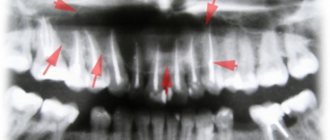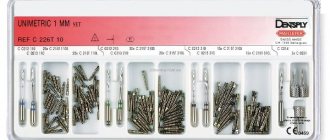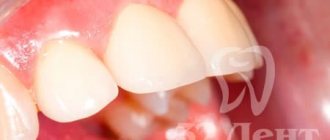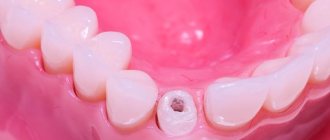An option for careful tooth restoration if the crown has collapsed to the base
Modern dentistry allows you to preserve natural teeth even when they are quite damaged. It is quite natural that one has to work very carefully with such problematic units, because the service life of the restored teeth will depend on how well the doctor does his work. And here the stage of endodontic treatment and canal filling will be of decisive importance. Today, filling canals with gutta-percha pins is considered one of the most reliable methods. And at the same time very affordable. What kind of technology is this, what are its features and advantages? We invite you to consider further.
Price issue
The cost of dental treatment using a gutta-percha pin is determined by the following factors:
- the number of roots of the damaged tooth;
- the complexity of the clinical situation and the presence of concomitant pathological processes;
- cost of construction;
- the use of painkillers and other medications used in the treatment process;
- region of residence of the patient;
- status of the clinic where treatment is carried out.
Based on the above conditions, the approximate price for the procedure will be:
- preliminary consultation and diagnostics – from 2000 rubles;
- pin - from 220 rubles;
- anesthetic – from 780;
- filling material – from 670;
- the cost of a dentist’s work is from 2,500 rubles.
Thus, the patient will have to pay at least 5,500 rubles.
The video provides additional information on the topic of the article.
What is a pin
Before moving on to what gutta-percha pins are in dentistry, let's basically understand what a pin is. This is a kind of rod or structure that has the necessary hardness to become a support for a badly damaged tooth that needs restoration due to deep caries, pulpitis, and traumatic injuries. This support allows you to avoid tooth extraction, restore it and extend its service life. This rod is placed and strengthened in the root system; it can act as a support for an artificial crown or prosthesis.
Some people call not only pins, but also implants rods. Indeed, these two designs are somewhat similar to each other, because both allow for high-quality tooth restoration. But they also have fundamental differences: the implant is installed in the patient’s jawbone in the absence of a tooth and performs the functions of a root. The pin is installed in the root of a natural tooth in order to give it a chance to continue serving its owner.
Dental practice has long used metal and fiberglass rods. But due to their invariably solid state, they could not provide one hundred percent sealing of the channels and all their branches, and often led to complications. They were used in conjunction with filling pastes, which also shrink over time, dissolve and form voids. However, today doctors have found a more advanced method that allows them to achieve high quality indicators of endodontic treatment. Specialists began to use gutta-percha points for teeth in their work.
Reviews
Despite a number of difficulties that arise during treatment with the use of gutta-percha, its use does not lose its relevance due to the low cost of the component, high strength and durability of structures made from it. Analogues that can become its worthy replacement. Not found yet.
If you are interested in the problem discussed in this article, you can leave your comment in the appropriate section. Surely this information will be useful to someone.
If you find an error, please select a piece of text and press Ctrl+Enter.
Tags gutta-percha pins tooth extension pins
Did you like the article? stay tuned
Previous article
About unfilling root canals in great detail
Next article
Features of using glass ionomer cement for filling teeth
What is gutta-percha in dentistry?
Gutta-percha material has been used in dentistry for more than a hundred years, used for the manufacture of temporary fillings and for endodontic treatment of canals. The word "gutta-percha" means flexible and pliable, and gutta-percha, which is used in dentistry, is a raw material that people obtain from the sap of the Isonandra gutta tree. Interestingly, chemical gutta-percha itself consists of a natural isomer of rubber or polyisoprene, but unlike ordinary rubber, it is still less elastic. Also, in terms of its properties and composition, some compare it with latex.
In its pure form, natural gutta-percha is not used in dentistry. To obtain the required consistency, experts add additional components to it:
- wax and resins that help soften the material,
- metal sulfate: this component is necessary so that the resulting material has good radiopacity, i.e. it will be clearly visible on x-rays, which makes it easier for doctors and allows them to control the treatment process at all stages,
- oxide or zinc oxide: the frame of the product is created from it and it makes up the largest percentage - about 70%. In addition, this element combines well with various sealers (fillers), without which the use of gutta-percha pins would not be so effective,
- dyes and antioxidants.
The percentage of natural gutta-percha in the composition of gutta-percha pins is no more than 20-22%.
On a note! Mentioning the composition of such rods, it is also worth noting that there are two modifications of gutta-percha - alpha and beta. The first has a lower melting point and, when exposed to not very high temperatures, becomes very plastic and sticky, but has low permeability. But the beta form melts at higher temperatures and when heated above 60 degrees it becomes ideal for filling root canals - it is this form that is used for the manufacture of gutta-percha points.
Features of the material
Using gutta-percha, the doctor has the opportunity to perform high-quality filling of dental canals and dental prosthetics. The material adequately copes with the task and has proven itself on the positive side.
The drug is made from the coagulated nectar of tropical plants. The structure of gutta-percha is an analogue of natural rubber.
The material has impeccable strength characteristics and is suitable for temporary and permanent filling.
The specific gravity of gutta-percha in the pins does not exceed 22%. Product characteristics vary depending on the content.
The material has a unique property - to create a sterile environment.
What are gutta-percha pins needed for: indications for use
Having read the description of the properties of a material such as gutta-percha, you probably already understood that pins made from it have high plasticity and, when exposed to high temperatures, are able to penetrate deeply even into the most curved canals and all their branches. Such rods are used in dental practice because they allow high-quality sealing and strengthening of the root canals of the tooth, their reliable obturation (translated from the Latin obturatio - clogging), reducing the risk of developing subsequent complications and ensuring good results for many years to come.
So, the use of gutta-percha points is justified if:
- the tooth is more than half destroyed,
- the tooth has only the root left,
- reliable support for an artificial crown or prosthesis is required,
- The patient has curved root canals.
Possible complications
Both during the procedure and at the rehabilitation stage, there is a risk of complications. They all have the same nature of origin - the source of inflammation.
The reason for this phenomenon is most often poor-quality cavity filling with material. The only solution in this case is to repeat all the manipulations, from sanitation to filling the canals.
An equally serious danger to the tooth is fraught with unintentional perforation. Its presence can be determined if the doctor’s working instrument begins to fall into the organ cavity.
If this happens, the affected area must be covered with cement mass and only then proceed with filling.
Types of products
When making rods from a material such as gutta-percha, specialists adhere to certain standards and rules. All factory-produced models (and they are produced by different manufacturers) comply with the standards of the country in which the manufacturer is located. Thus, German companies produce products according to the standards of the German Institute for Standardization DIN, American companies - to ADA (American Dental Association) standards, Russian manufacturers - to GOST standards developed by the All-Russian Scientific Research Institute for Certification. All gutta-percha points are also manufactured in strict accordance with ISO standards.
In general, according to types, experts divide them into two large groups: standard (main) and non-standard or additional gutta-percha points. The first group has standardized sizes: 15, 20, 25, 30, 35, 40, 45, 50, 55, 60, 70, 80, 90, 100, 110, 120, 130, 140. Such products are color-coded and fully comply standards of cutting instruments that doctors use in their work according to ISO. For the convenience of dentists today, standardized types of structures also have special millimeter markings along the length.
As for additional models, the length and width of such gutta-percha pins also vary. There are only five types: there are models marked XXF (super-thin), XF (very thin), F (thin), M (medium size), L (thick or large). Unlike conventional models, they are all cone-shaped and tapered at the end. The cones of such products can also have different sizes: from 0.04 to 0.012. Such models are mainly used according to the vertical condensation installation method, which you will find information about below.
The doctor selects the size and type of product based on the clinical situation.
What are they made of?
A gutta-percha pin is made in the form of a rod and is used to restore a dental crown. The main material is zinc oxide. It makes up from 59% to 76% of the total mass. Also includes:
- Beta-gutta-percha from 18% to 22%.
- From one to 4% are plasticizer candles.
- Radiocontrast agents up to 1.5%.
- Antioxidants.
- Biological dyes.
The pin is combined with silvers, which include Evengol. This is due to the presence of zinc oxide. Substances form a homogeneous mass by bonding with each other.
The presence of dyes in the composition allows you to give the pins a color in accordance with its size.
Advantages of gutta-percha rods
Let's take a closer look at the positive properties of gutta-percha pins:
- biological inertness: this quality is even better than that of such noble metals as gold and silver. This property ensures the absence of allergic reactions in the patient,
- ability to condense: after hardening, this material adheres very tightly to dentin,
- stability: throughout the entire service life, the material does not change its volume, practically does not shrink and does not dissolve,
- wear resistance: the material does not collapse,
- tightness: gutta-percha is able to fill all branches of the root canals and protect them from penetration of infection, moisture,
- softening when heated: this gives doctors the opportunity to evenly distribute it along the entire length of the canals and give it the desired shape. This property also facilitates the doctor’s work, allowing him to quickly and easily perform all manipulations using special syringes and rods for introducing the material,
- no toxicity,
- radiopacity: a specialist always has the opportunity to monitor the quality of work by taking an x-ray,
- possibility of removing material if necessary.
Another advantage is that treatment using these structures today is accessible to a wide range of patients due to the low cost of such material as gutta-percha.
Prevention of pulpitis and caries
The main reason for filling root canals is the complication of pulpitis and caries. Both of these diseases can occur in chronic or acute forms. Therefore, the first stage of prevention is timely treatment and consultation with a doctor.
Pulpitis is accompanied by pain of various types. Therefore, people often take painkillers and schedule visits to the dentist. At this time, the disease progresses successfully. The same situation occurs with caries. Only in this case does the successful development of microorganisms occur, which lead to the destruction of tooth enamel and roots.
Prevention consists of very simple rules:
- visit the dentist once every six months,
- If you suspect a disease, do not postpone visiting a doctor,
- proper care of teeth and oral cavity,
- proper nutrition,
- maintaining hygiene.
Root canal filling is a complex procedure. It is easier to start treatment on time than to allow such manipulations to take place.
Disadvantage information
- poor adhesion to hard tooth tissues: the adhesive properties of the material are very weak; in order to enhance the quality of adhesion, specialists practice installing gutta-percha pins together with root sealants and sealers. If this rule is violated, then there is a high probability that the flexible rods may move after installation,
- lack of bacteriostatic effect: due to its biological inertness, i.e. passivity, the material does not promote the regeneration of tooth tissue, it does not release useful active compounds,
- difficulties during installation: in order to work with such a flexible and plastic material and install it efficiently, the doctor must have a high level of professionalism. When preparing for procedures, the rods can stretch, which makes it difficult for the doctor to control the working length of the canal later. Particular difficulties are caused by the flexibility of the rods when filling thin canals, because... rods up to size 35 do not have any noticeable rigidity and are too plastic,
- uneven distribution of load on the root, which is fraught with its rapid destruction.
General stages of tooth treatment using gutta-percha points
Filling canals using gutta-percha pins usually takes place in several stages.
Stage 1: drilling out carious lesions and damaged hard tissues using a bur.
Stage 2: removal of the tooth nerve using pulp extractors.
Stage 3: preparation of root canals. At this stage, the doctor first measures their length using tools such as depth gauges. Next, the specialist widens the mouth of the canals using tools called drills and K-files. Reamers are also used for root canals. Next, the doctor performs an antiseptic treatment of the work areas.
Stage 4: determining the type and size of the required pin. To determine the size, the specialist uses tools suitable for this purpose. For example, “Verifer” is a kind of flexible needle that tapers at the end.
Stage 5: selecting a sealer (filling paste) and filling the canal with it. The sealer simply must be used in conjunction with gutta-percha pins, because otherwise it will be impossible to ensure high-quality sealing and protection of all branches from moisture and bacteria, as well as reliable adhesion of flexible rods in the root system. The sealer also acts as a good lubricant, allowing the flexible gutta-percha rod to pass easily through hard-to-reach areas. Filling pastes differ in their composition; they can be created on the basis of epoxy resin, glass ionomers, gutta-percha, calcium hydroxide, zinc oxide, and polyesters. The sealer is placed in the designated areas using channel fillers.
Stage 6: installation of the pin. Once the structure is correctly placed along the entire length of the canal, the doctor cuts off its upper part, located at the level of the mouth, using an instrument heated to high temperatures. Find information below about installation methods for flexible gutta-percha products.
Important! Due to the high temperature nature of the material, it cannot be sterilized, but it can be disinfected and decontaminated before use using isopropyl alcohol or two percent chlorhexidine, or by immersion in sodium hypochlorite. It is simply necessary to do this, because... the material will come into close interaction with the periapical tissues of the tooth.
Stage 7: installation of a temporary composite filling. Why can’t you immediately install a permanent one? A professional doctor needs to make sure that the endodontic treatment was carried out efficiently, all cavities are sealed hermetically, and the patient will not subsequently experience any complications requiring tooth retreatment.
Stage 8: installation of a permanent filling. You can begin installing a permanent filling 4-5 days after endodontic treatment has been carried out. First, the doctor will conduct an x-ray control (it is also necessary to conduct x-rays at all stages of endodontic treatment). After a permanent filling has been placed, it is also recommended to think about strengthening the tooth with an artificial crown, especially if the damage has been significant and the filling is large enough. This measure will help preserve the results of treatment for many years.
Tags
Tooth extraction removal of teeth Removal of wisdom teeth impacted teeth implantation of teeth cysts of a tooth Removal of a tooth under Dental implantation of 1 tooth of the upper teeth Treatment of a cyst Treatment of teeth Treatment of caries Treatment of gingivitis Treatment of periodontitis Treatment of roots Treatment of exposure Treatment of alveolitis Dental treatment Dental treatment Fixed prosthetics Removable prosthetics
prostheticsfillingsbite consultationrestorationimplantationsdentalpricesbracesveneersappointmentcleaningjawwhiteningremovablealignersarticlescasestabliftingmouthservicesclinicssharesstumprestorationMoscowsign upimplantconstructionscontactsusedplasticsapparatusesorthodonticsallowscorrectionofcystsceramictherapyhotconsentdiagnosisconsequenceschildren byugelnoeyoursendcangumhygienewayssurgerymedicalcauseradiologicallyfacedataprocessingpersonallaserpleaseimplantsenter
Gutta-percha filling techniques
In fact, there are quite a lot of methods for filling with gutta-percha pins. All of them can be divided into two groups: cold and hot methods.
In the first case, the specialist introduces cold material into the root canal and only then heats it. In the second case, the material will be preliminarily exposed to high temperatures and will be introduced into the root canal in a heated state. In practice, specialists use “hot” methods more often because they are more reliable. But with “cold” ones, there is a possibility that not all cavities and branches of the canals will be filled, which will subsequently lead to their infection and the development of a disease such as periodontitis.
Let's take a closer look at all the techniques that use cold and hot gutta-percha.
First, let's look at cold material installation methods.
"One pin" method
In the literature, this method is sometimes called the monopin technique1, because its implementation requires only one pin, as well as a sealer. First, the doctor develops the root canal (passes, expands, disinfects), then applies a sealer as a base, after which he inserts a rod of a suitable size. The paste fills all the gaps, and the protruding ends of the rod are removed with a hot tool (a special nozzle, a smoothing iron or a regular probe is used for this purpose, which are heated to 150-200 degrees). After which the doctor follows the standard procedure and fills the tooth.
Lateral or side condensation method
The technique is very popular and effective for filling wide root canals. To implement it, you again need a sealer and a set of standard gutta-percha rods (4-5 or more pieces may be required). First, the doctor treats the canal walls with filling paste, then, one by one, pins are inserted into the mouth and compacted, moistened at the end with sealer. Each subsequent pin is condensed by a special sealing tool spreader (it is also called a side seal) to the walls of the canal and enters it to an ever-smaller depth - this happens until the entire lumen is filled and compacted (when this happens, the spreader tool is no longer possible will be pushed into the channel). Each installed rod is cut off from above with a hot tool. The mouth is closed from above with heated gutta-percha.
The method, however, has a number of disadvantages, for example, during its implementation, quite strong pressure is applied to the root of the tooth, which can lead to damage if the doctor is unprofessional. The disadvantage of the technique is that in the apical apical region the pin cannot guarantee a high level of sealing, because it cannot be heated here.
On a note! There are two more methods of filling with cold gutta-percha pins, but these days they are not used due to low efficiency and a high risk of complications. For example, thermomechanical condensation technology involves the use of a rotating tool to place rods into designated areas. However, this mechanism increases the risk of canal damage. Another method involves softening the material under the influence of chemical activators, which also have a very negative effect on tooth tissue.
Now let's look at techniques that involve filling with preheated gutta-percha.
Hot vertical condensation method
This technology is very complex and requires a lot of time, as well as high professionalism of the doctor. However, it has a significant advantage over other methods - it gives really good results, because provides three-dimensional filling of the root canal. To implement this type of endodontic treatment, the doctor will need to be equipped with special equipment that has a spreader attachment for heating gutta-percha and a plugger tool for carrying out vertical condensation. At all stages, the doctor selects pluggers of different sizes to compact the material.
What is the essence of the method: the doctor gradually fills the root area - first the lower third of the root, then the middle and only then the coronal part. The specialist takes the pin and immerses its tip in the sealer, after which the rod is compacted into the root canal. Next, using a heated nozzle, the specialist cuts off the tip of the rod at the level of the canal mouth and gradually condenses the heated material, slowly immersing the heated nozzle into it. This approach makes gutta-percha as flexible as possible, and it, in turn, literally repeats all the anatomical features of the root system and hermetically fills all cavities, including lateral branches, leaving no gaps. Throughout all stages of treatment, the doctor takes an x-ray, and at the control stage fills the very upper part of the canal with heated gutta-percha.
Thermafill method
This is the technology of so-called “volumetric filling”. To implement the method, special equipment and a heating oven are also required. Thermafil is a special plastic rod on which gutta-percha is applied. To activate it, the doctor first places the material in the oven for 15 seconds, then removes it and places it under pressure into the tooth cavity. As a result, the material easily fills even the smallest branches and curved cavities, and the rod itself compacts and compacts the heated gutta-percha.
These are the most popular and effective methods today. However, in some dentistry, doctors administer gutta-percha preheated to 200 degrees using syringes or injections. But this approach does not guarantee hermetic filling of all cavities. In addition, it involves a rather difficult rehabilitation period associated with physical discomfort for the patient.










